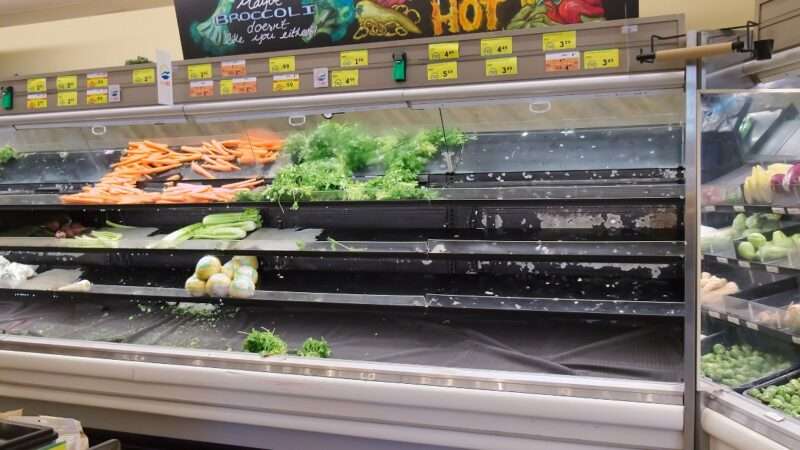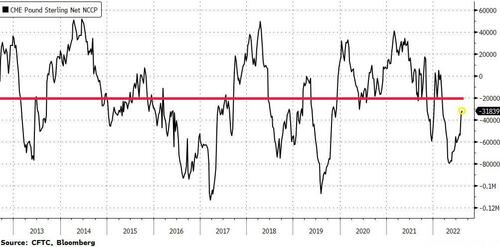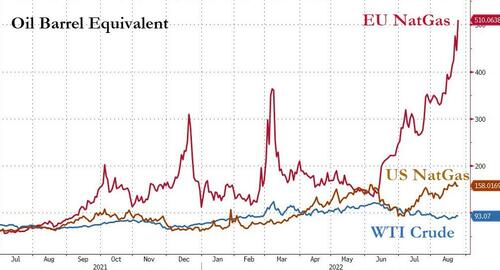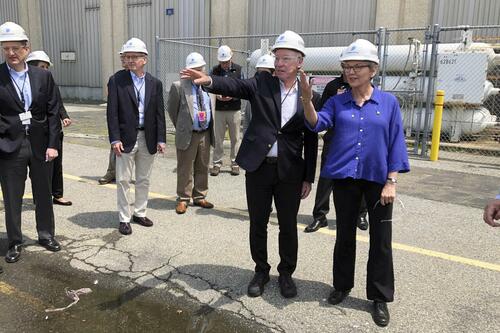The day we’ve all been waiting for has finally arrived as Jerome Powell prepares for his keynote hawknado speech at the
“Action Jackson” Hole.

After yesterday’s unexpected last hour rally, US stock futures dropped and interest rates rose as jittery investor nerves took hold before Federal Reserve Chair Jerome Powell’s much-anticipated (hawkish) speech at the Jackson Hole symposium. S&P futures dropped 0.4% in a subdued session, while Nasdaq 100 futures fell 0.5% as of 7:15 a.m. ET. Both underlying indexes jumped Thursday, paring losses from earlier in the week, as bond yields dropped. Still, the benchmark S&P 500 is set for its second straight weekly decline as Fed policy makers sounded more hawkish about their outlook on rate hikes, even amid growing fears of a recession.

Among notable movers in premarket trading, Affirm Holdings Inc. slumped after the payments company gave a revenue forecast for 2023 that missed the average analyst estimate. Shares of Dell Technologies also fell more than 4% following bearish remarks from the PC maker about the business environment for the second half. Other notable premarket movers:
- Farfetch (FTCH US) rises 16% in premarket trading after the company posted a 2Q revenue beat, with analysts highlighting strong growth prospects for 2023 and resilient core results.
- Gap (GPS US) gains 8% in premarket trading after the apparel retailer reported a surprise profit and improving sales trends.
- Workday (WDAY US) rises 11% in premarket trading after the application software company reported second-quarter results that beat expectations and reiterated its forecast for the year.
- Marvell Technology (MRVL US) fell 1.4% in postmarket trading. The firm’s softer guidance is disappointing, with weakness in some key growth areas, analysts said.
- Ulta Beauty’s (ULTA US) quarterly results beat on most metrics, prompting price-target raises for the beauty products retailer. The shares rose 3% in postmarket trading.
Of course, today’s main event is Powell’s speech scheduled for 10 a.m. Washington time, where the Fed chair is expected to restate the central bank’s resolve to keep tightening policy to fight elevated inflation. Mark Haefele, chief investment officer at UBS Global Wealth Management, said the stakes are high for what Powell signals today as inflation will likely drive the trajectory of stocks over the next year. “If the Fed’s incremental rate hikes are effective at cooling today’s rampant inflation, Powell could lead to market upside over the course of the next year,” Haefele wrote. “But if the Fed, or the market misjudge the direction and drivers of inflation, outcomes for investors would likely be much worse.”
“The reality is that the Fed will want to be sure that inflation is falling at a sustainable enough pace before it signals any sort of dovish shift or pivot,” said Michael Hewson, chief market analyst at CMC Markets UK. “This puts Powell in the rather tricky position of having to let markets down gently.”
As Oanda’s Craig Erlam writes, there is “no doubt Powell will have chosen his words very carefully today, all too aware of the consequences of even the smallest deviation in his intended message. It’s a little ridiculous that markets put so much weight on such things but that is the situation we are in and I expect the Fed Chair will be very clear in the message he wants to send. The difficulty for Powell stems from the fact that there’s the message investors desperately want to hear and the one they’ve repeatedly ignored since the July Fed meeting.”
Erlam adds that the “dovish pivot” played nicely into the hands of the perma-bulls that have waited impatiently for the stock market to recover this year. Despite policymakers’ best efforts, “attempts to correct this narrative have been brushed aside and the view today is that Powell may try to address this in a more forceful and convincing way.” But, “if he fails or gives the slightest impression that there is any substance to the dovish pivot narrative, we could see yields slip and stock markets end the week on a high. That could come intentionally, or otherwise, but investors will be clinging to his every word for even the slightest hint. Especially in light of the recent inflation reading. No pressure.”
Duration and rate-sensitive tech stocks will be in particular focus in the aftermath of the J-Hole conclave after leading the sharp recovery in US stocks since mid-June. Higher interest rates mean a bigger DCF discount, hurting growth stocks with the highest valuations, including technology, and boosting cheap or so-called value shares. As Bloomberg notes, market watchers will be cautious about further gains for the sector after the technology-heavy Nasdaq 100 rallied more than 20% from its June low, making valuations more expensive again. In the week to Aug. 24, technology funds saw the biggest outflows since November 2021, according to a note from Bank of America Corp. citing EPFR Global Data.
European equities tracked US futures, and turned negative after gaining in early trading. The Stoxx Europe 600 Index dropped 0.4% giving up earlier gains of as much as 0.5%. Miners and banks outperformed, while media stocks were laggards. Media, travel and food & beverages lag while miners, banks and autos outperform. The summer rally in European shares has run into concerns that the Fed will continue raising rates to tame inflation despite fears of an economic slump. The main regional benchmark is set for a second week of losses. Here are some of the biggest European movers today:
- SKF shares rise as much as 7.2% after activist investment firm Cevian Capital boosted its stake in the Swedish industrial group. Analysts say the firm could be on the verge of meaningful change
- European mining companies are the best-performing group in Stoxx 600 benchmark on Friday, as iron ore gained. Base metals also edged higher amid China’s efforts to stimulate its economy
- GSK, Sanofi and Haleon shares all gain as Citi opens positive catalyst watches on GSK and Sanofi following a tentative ruling that could mean the settlement on Zantac is significantly lower than expected
- Micro Focus International shares rise as much as 94% after Canada’s OpenText agrees to buy the UK software firm for 532p/share, implying an enterprise value of about $6b
- Molecular Partners rises as much as 8.6% after the biotech reported 2Q results that came in line with expectations. RBC says the firm has a strong cash position, which remains the key financial metric
- SFS shares are up as much as 6%, most since December 2021, after the company reported a sales beat, with analysts welcoming the new margin guidance, saying it represents upside to consensus estimates
- Eurocommercial Properties shares gain as much as 7.4%, the most intraday since March 29, after the real estate investment firm reported better- than-expected net property income
- RELX shares dip 3.7% and Wolters Kluwer shares drop 2.5% and drag on the Stoxx 600 Media index, with Citi flagging negative sentiment for the media groups from US Open Access plans
- Lundbergforetagen slides, falling as much as 3.3%, as Handelsbanken warns of the risk that the Swedish property investment firm’s net asset value (NAV) discount could increase still further
- H&M shares drop as much as 2.1% as price targets are cut at at least three more brokers, with analysts bearish on the outlook for the Swedish fast- fashion retailer amid a weaker consumer environment
Earlier in the session, Asian stocks advanced for a second day, as technology stocks gained ahead of Federal Reserve Chair Jerome Powell’s speech at Jackson Hole. The MSCI Asia Pacific Index climbed 0.4%, trimming gains later in the day as US futures slipped. TSMC and Samsung were among the biggest boosts as global chipmakers rallied, while Alibaba and peers climbed after reports of talks to avoid delistings of Chinese stocks in New York. Australia stocks were among the biggest gainers, with the benchmark gauge up 0.8%. Investors will monitor Powell’s remarks later Friday for clues on the path of the Fed’s interest rate hikes ahead of its September meeting. Recent comments by Fed officials have indicated the US central bank may focus on taming high inflation, triggering a selloff in equities earlier this week. Read: Fed’s Jackson Hole Conference Is Underway: Here’s What to Expect “To some degree, we are expecting Chair Powell may well push back against the ideas that we should expect the dovish pivot any time soon,” Audrey Goh, an investment strategist at Standard Chartered Bank SG, said in an interview with Bloomberg TV. “Whether this rally will extend, I think the key is really the dollar. We really need to see a weak dollar for risk assets to sustain recovery,” she said. Friday’s advance following a jump in the previous session has helped the MSCI’s Asian stock benchmark finish the week almost flat. The gauge had slumped earlier in the week amid concerns that the Fed may ramp up its hawkishness and mixed corporate earnings. The gauge is down 17% this year, underperforming global peers on steep losses in Chinese shares
Japanese stocks tracked gains in US peers as investors weighed comments from Federal Reserve officials which signaled a resolve to tighten further to tame inflation. The Topix rose 0.2% to close at 1,979.59, while the Nikkei advanced 0.6% to 28,641.38. Sony Group Corp. contributed the most to the Topix gain, increasing 1% as the company said it will increase PlayStation 5 console prices in certain countries. Out of 2,170 stocks in the index, 1,053 rose and 969 fell, while 148 were unchanged. St. Louis Fed chief James Bullard said officials should act quickly and lift their policy benchmark to a 3.75% to 4% range by year end. Bullard spoke to CNBC in Jackson Hole, where Fed Chair Jerome Powell is due to make a speech Friday. “For Japan stocks the remarks will have a different aspect depending on the industry, with a more hawkish tone favorable for export-related stocks as interest rates rise and the yen will weaken,” said Tomo Kinoshita, a global market strategist at Invesco Asset Management. But, “overall, of course the more dovish the more favorable it will be for the markets.”
Australia’s S&P/ASX 200 index rose 0.8% to close at 7,104.10, boosted by banks and mining shares. Soaring profits unveiled by Australian miners this week were a beacon of light amid the gloom dominating economic headlines. The benchmark erased 0.2% this week, snapping five weeks of gains, in the lead up to Federal Reserve Chair Jerome Powell’s speech at Jackson Hole on Friday. Investors will monitor Powell’s remarks for clues on the path of the Fed’s interest rate hikes ahead of its September meeting. In New Zealand, the S&P/NZX 50 index fell 0.2% to 11,608.29
Stocks in India rose in line with Asian peers on Friday as Kotak Mahindra Bank and Larsen & Toubro gained. The key equity gauges still posted their first weekly drops since mid-July, with investors remaining cautious ahead of the US Federal Reserve’s commentary about monetary-policy outlook. The S&P BSE Sensex rose 0.1% to 58,833.87 in Mumbai, paring its weekly loss to 1.4%. The NSE Nifty 50 Index climbed 0.2% on Friday. Among the 30 members on the Sensex, 19 gained and 11 fell. The gauge on Thursday took a surprise dive in the last hour of trade due to the expiry of the monthly derivative contracts. Much of the advance in Indian stocks since June have been driven by purchases by foreign investors. However, the inflows moderated this week on risk-aversion ahead of Fed Chair Jerome Powell’s speech at the Jackson Hole symposium on Friday, which will help investors gauge the future course of rate hikes by the US central bank. Foreign investors have purchased $110m of Indian stocks this week through Aug. 24, compared with net buying of more than $1 billion for preceding three weeks.
In FX, the greenback pared gains against most of its Group-of-10 currencies. DKK and EUR are the strongest performers in G-10 FX, NZD and GBP underperform. The Bloomberg Dollar Spot Index little changed after rising 0.3% earlier. As Powell delivers the much anticipated speech, “markets may find enough reason to push their peak rate pricing closer to the 4.0% mark today, which should ultimately offer some support to the dollar,” Francesco Pesole, a strategist at ING Groep NV wrote in a note.
Australian and New Zealand dollars fell the most among G-10 currencies as they were sold by fast money funds in last minute positioning ahead of Powell’s speech, according to Asia-based FX traders. “The Fed has been pretty clear in its messaging so I would be surprised if Powell suddenly changed direction or threw something else into the mix,” said Darren Langer, co-head of Australian fixed income at Yarra Capital
- EUR/GBP up 0.3%; GBP/USD down 0.1%. The pound fell as much as 0.5% after the UK energy regulator raised the caps on energy prices, a move likely to escalate inflationary pressures
- NZD/USD fell 0.3% to 0.621. The Reserve Bank of New Zealand Governor Adrian Orr forecast sharply slower economic growth to constrain demand and tamp down inflation while suggesting the central bank may be nearing the end of its aggressive hiking cycle
- AUD/USD dropped 0.1% to 0.6955 after falling as much as 0.4%
- USD/JPY rose 0.3% to 136.886
In rates, Treasuries were lower led by intermediates, re-steepening 2s10s spread back toward middle of Thursday’s range. Bunds and more notably gilts outperform Treasuries, while S&P 500 futures are also under pressure with European stocks. US 10-year yield 3.07% is cheaper by 5bp on the day, underperforming bunds by ~1bp, gilts by ~5bp; 2s10s is steeper by ~4bp with front-end Treasuries only marginally cheaper on the day. Bunds 10-year yield up about 2 bps to 1.33%, while gilts appear relatively muted in comparison as 10-year yield is unchanged at 2.61. IG dollar issuance slate empty so far, and just $1.3b of new supply has been seen this week. Three-month dollar Libor +2.64bp to 3.06957%.
In commodities, WTI trades within Thursday’s range, adding 0.6% to around $93. Most base metals are in the green; LME nickel rises 1.6%, outperforming peers. Spot gold falls roughly $6 to trade near $1,752/oz. Bitcoin and ethereum both slumped, going back to levels last ween on Wednesday.
To the day ahead now, the main highlight will be Fed Chair Powell’s speech at Jackson Hole. Otherwise, data releases from the US include July’s personal income and personal spending, along with the University of Michigan’s final consumer sentiment index for August. From Europe, there’s the GfK consumer confidence index from Germany for September, as well as consumer confidence readings from France and Italy too for August.
Market Snapshot
- S&P 500 futures down 0.3% to 4,190.00
- STOXX Europe 600 little changed at 433.05
- MXAP up 0.4% to 160.81
- MXAPJ up 0.5% to 525.76
- Nikkei up 0.6% to 28,641.38
- Topix up 0.2% to 1,979.59
- Hang Seng Index up 1.0% to 20,170.04
- Shanghai Composite down 0.3% to 3,236.22
- Sensex up 0.4% to 59,023.37
- Australia S&P/ASX 200 up 0.8% to 7,104.06
- Kospi up 0.2% to 2,481.03
- German 10Y yield little changed at 1.34%
- Euro little changed at $0.9978
- Brent Futures up 0.9% to $100.20/bbl
- Brent Futures up 0.9% to $100.21/bbl
- Gold spot down 0.4% to $1,751.78
- U.S. Dollar Index little changed at 108.54
Top Overnight News from Bloomberg
- From canceling Friday night trips to the pub to pushing back soccer practice, global investors are pulling out all the stops to ensure they’re ready for the most important gathering of central bankers this year.
- China is using China Aerospace Science and Industry Corp to ship millions of barrels of Venezuelan oil despite US sanctions, Reuters reports, citing three unidentified people and tanker tracking data
- Europeans are taking colder showers, offices are turning down thermostats and stores are dimming lights to avoid blackouts and freezing homes this winter in the fallout from Russia’s war in Ukraine
- The cost of French power jumped to a fresh record as its nuclear fleet faces further outages going into what’s set to be a very expensive winter. UK households will pay almost triple the price to heat their homes this winter compared with a year ago
A more detailed look at global markets courtesy of Newsquawk
Asia-Pac stocks took impetus from Wall St where stocks eventually shrugged off the initial choppy mood and ramped up heading into the close with outperformance in the Nasdaq amid a lower yield environment. ASX 200 was underpinned amid a slew of earnings releases and with the consumer-related sectors leading the gains after Australia’s largest retailer Wesfarmers reported a 9% increase in revenue. Nikkei 225 gained from the open with the index unfazed by firm Tokyo CPI data which printed its fastest pace of increase since 2014, as this is seen as unlikely to trigger an adjustment of BoJ policy. Hang Seng and Shanghai Comp conformed to the constructive mood as participants digested a slew of earnings results including PetroChina’s record profit and with tech stocks buoyed after delisting concerns were soothed by reports that China and the US are nearing a deal regarding company audits.
Top Asian News
- US suspended 26 US flights by Chinese carriers after China’s COVID action limited some US flights, according to the DOT cited by Reuters.
- Chinese state planner official says domestic inflation is likely to quicken slightly later in 2022 and early next year.
- China has asked some US-listed Chinese companies and their audit firms to make preparations for American inspections in Hong Kong, according to Reuters sources.
- Chinese Financial Regulators have informally told lenders to make more loans, and raise some banks’ loan quotas and loan-growth requirements, according to Reuters sources.
European bourses are currently contained, Euro Stoxx 50 -0.2%, as initial price action eased with catalyst thin pre-Powell. Stateside, futures are under modest pressure, ES -0.4%, and the NQ -0.6% lags slightly given modest yield upside. US Chip software producer Synopsys is set to expand into Vietnam amid the Chinese tech war, according to the Nikkei. Panasonic (6752 JT) says they are considering various EV battery business strategies, nothing decided yet.
Top European News
- Ofgem UK Energy Price Cap – Q4 2022 (GBP): Default 3549 (prev. 1971, exp. 3582), +80.06%; Standard Credit 3764 (prev. 2100), +79.2%; Prepayment Meter 3641 (prev. 2017), +80.5%.
- UK Tory leadership frontrunner Truss is considering plans to invoke Article 16 regarding the Northern Ireland Protocol within days if she becomes the next PM, according to government insiders cited by FT.
- UK Tory leadership frontrunner Truss has reportedly been meeting with the business secretary and her prospective chancellor regarding a significant support package to help with energy bills, according to The Times citing sources.
- German Economy Ministry spokesperson says they are looking at changes to the gas levy.
FX
- DXY fades earlier gains but trades within a 108.25-75 range throughout the morning.
- EUR outperforms and has been resilient as EUR/USD sees large OpEx above parity.
- GBP, AUD, CHF, and CAD are all relatively flat vs the Buck, whilst NZD and JPY lag.
Fixed Income
- Despite fairly pronounced ranges, over 100 ticks in Bunds, the general tone is tentative with benchmarks within WTD parameters.
- USTs are pressured, with yields elevated and the curve bear-steepening but, again, well within recent ranges.
- SONIA strip takes a slight dovish skew, though Gilts unfased, following the as-expected Ofgem cap announcement.
Commodities
- WTI and Brent October contracts are consolidating following yesterday’s slide in prices.
- Spot gold resides around USD 1,750/oz after dipping under its 10 DMA (USD 1,756.60/oz)
- Base metals are mixed but copper prices remain supported and reside around USD 8,250/t.
- UAE is supportive of the latest statement from Saudi Arabia on crude markets, via Reuters citing sources.
- Four ships loaded with grain are leaving Ukrainian ports and another five ships are arriving for loading, according to Al Jazeera citing the Turkish Defense Ministry.
US Event Calendar
- 08:30: July Personal Income, est. 0.6%, prior 0.6%
- July Personal Spending, est. 0.5%, prior 1.1%
- July Real Personal Spending, est. 0.4%, prior 0.1%
- 08:30: July PCE Deflator MoM, est. 0%, prior 1.0%; PCE Deflator YoY, est. 6.4%, prior 6.8%
- 08:30: July PCE Core Deflator MoM, est. 0.2%, prior 0.6%; PCE Core Deflator YoY, est. 4.7%, prior 4.8%
- 08:30: July Retail Inventories MoM, est. 1.2%, prior 2.0%
- July Wholesale Inventories MoM, est. 1.4%, prior 1.8%
- 08:30: July Advance Goods Trade Balance, est. -$98.5b, prior -$98.2b, revised – $98.6b
- 10:00: Aug. U. of Mich. Sentiment, est. 55.4, prior 55.1
- Aug. U. of Mich. Expectations, est. 55.0, prior 54.9
- Aug. U. of Mich. Current Conditions, est. 55.6, prior 55.5
- Aug. U. of Mich. 1 Yr Inflation, est. 5.0%, prior 5.0%; 5-10 Yr Inflation, est. 3.0%, prior 3.0%
DB’s Jim Reid concludes the overnight wrap
After much anticipation over the quiet summer season, today will finally see Fed Chair Powell deliver his annual speech at Jackson Hole. When we heard from Powell following the last FOMC meeting in July, markets interpreted his comments in a dovish light that helped send risk assets on a strong rally over the following weeks. That was given further fuel by the much weaker-than-expected CPI print a couple of weeks back too. But that narrative moved into reverse over the last week or so, in part due to mounting expectations that Powell could deliver a more hawkish message later today, and investors have responded accordingly. Indeed, the rate which Fed funds futures are pricing in for December 2023 is up by +75bps since the start of the month, as investors have shifted their expectations closer towards what FOMC officials have actually been saying about the future path of rates.
Irrespective of the leaning of Powell’s remarks, today is likely to mark a big divergence from the messages of recent years. It was only back in 2019 that Powell used his speech to comment that “Low inflation seems to be the problem of this era, not high inflation.” Then in 2020 as he discussed the Fed’s review of their monetary policy framework, he said that “The persistent undershoot of inflation from our 2 percent longer-run objective is a cause for concern.” And even in 2021 as inflation had risen above target, Powell discussed why the inflation spike was likely be temporary, citing factors such as the absence of broad-based price pressures. So we’ve come a long way since then.
In terms of what to look out for today, our US economists don’t expect that Powell will deliver explicit guidance for the September meeting given that we’ve still got another jobs report and CPI print beforehand. However, they do think he’ll likely to skew his remarks in a hawkish direction to ensure the Fed’s inflation-fighting credentials are unquestioned, not least after the comments from July were interpreted in a dovish light. You can read their full preview here.
With all that to look forward to, markets put in a very strong performance over the last 24 hours, with the S&P 500 (+1.41%) seeing its largest gain in nearly two weeks, just as sovereign bonds have also rallied on both sides of the Atlantic. Sentiment was boosted by hopes that Powell might not be as hawkish as some fear, along with better-than-expected data releases. They included the US weekly initial jobless claims for the week through August 20, which fell to 243k (vs. 252k expected), as well as the continuing claims for the previous week which fell to 1.415m (vs. 1.441m expected). On top of that, Q2’s GDP contraction was revised to show a shallower -0.6% annualised decline (vs. -0.9% previously).
Those more positive moves for key assets came in spite of the latest deterioration in Europe’s energy situation, as the continent experienced yet another day of record prices. Natural gas futures surged a further +10.02% to settle at a new high of €321 per megawatt-hour. And if that wasn’t enough, German power prices for next year saw their largest daily increase so far in 2022, with an astonishing +16.39% rise taking them to their own record of €748 per megawatt-hour. Meanwhile in France, EDF announced they were extending the return dates following a number of reactor outages, and power prices for next year rose +14.99% to €903 per megawatt-hour. Finally in the UK, today will see the energy regulator Ofgem announce the latest energy price cap that will apply from October, and as our UK economist has written (link here) we could see a rise of around 80%.
Unlike the pattern over recent days however, this latest inflationary impulse failed to knock sovereign bonds. Indeed, the moves brought a stop to a run of 7 consecutive declines for European sovereigns that’s taken 10yr bund yields up by +47bps over that time. By the close of trade, yields on 10yr bunds (-5.4bps), OATs (-5.6bps) and BTPs (-12.8bps) had all fallen back, and peripheral spreads also tightened in line with the broader risk-on move across asset classes.
Back in the US, Treasuries put in a similarly strong rally and 10yr yields fell -7.8bps to 3.03%, even as Fed officials continued to point in a hawkish direction ahead of Powell’s remarks today. Early in the day we heard from Atlanta Fed President Bostic, who said regarding the September meeting that “at this point, I’d toss a coin between the two” on whether to hike by 75bps again or 50bps. We then heard from Kansas City Fed President George, who said there was “more room to go” on hiking rates. And Philadelphia Fed President Harker said that “we don’t need to rush way up and then way down – we need to go up and sit for a while and let things play out”. So comments that point away from swift reversal after the hiking cycle has concluded. Finally, St Louis Fed President Bullard repeated his stance of moving rates to 3.75-4% by the end of the year, so 150bps higher than at present, and said that he favoured frontloading rate hikes.
Equities saw little reaction to any of the Fed commentary yesterday, although there was a strong rally in the final hour of US trading that helped the S&P 500 (+1.41%) record a broad-based advance where every sector moved higher on the day. The more cyclical sectors led the gains, with megacap tech stocks outperforming as the FANG+ Index rose +3.06%. In Europe, the main indices closed before that late surge, yet the STOXX 600 still posted a +0.30% gain.
That equity rally has continued in Asia this morning, where Chinese equities have been further supported by reports that regulators are making progress in talks over the delisting of companies in New York. Against that backdrop, the major indices in the region are all in positive territory, with the Nikkei (+0.72%) leading the way, followed by the Hang Seng (+0.70%), the KOSPI (+0.27%) and the CSI 300 (+0.02%). We also got some inflation data from Japan for August, where Tokyo’s CPI came in above expectations at +2.9% (vs. +2.7% expected). Looking forward however, the mood is a bit less optimistic, with S&P 500 futures down -0.13% this morning ahead of Powell’s speech later. 10yr Treasuries have also reversed course with a +2.4bps rise in yields to 3.05%.
With everything else going on, the release of the ECB minutes from their July meeting got somewhat less attention. Nevertheless, there were still some interesting headlines, including that “some members” were in favour of a smaller 25bp move at the last meeting, since that was what had been indicated in June, and that with “recession risks looming, an increase of 25 basis points was seen as more in line with a gradual monetary policy normalisation.” The minutes also pointed out how “there might be more persistence in the inflation process than embedded in models where parameters were maintained at the values that had been estimated in a low-inflation environment”. Separately, there were some negative comments about forward guidance moving forward, with the comment that “specific forward guidance” on rates “was seen as excessively constraining the Governing Council’s optionality, flexibility and data-dependence”.
Looking at yesterday’s other data, German GDP growth in Q2 was revised a tenth higher from the preliminary estimate to show a +0.1% expansion. Furthermore, the Ifo’s business climate indicator for August also held up better than expected, with the reading “only” falling back to 88.5 (vs. 86.8 expected), although it was still the lowest since June 2020. Otherwise, the Kansas City Fed’s manufacturing index for August fell back to 3 (vs. 10 expected), which was its lowest level since July 2020.
To the day ahead now, and the main highlight will be Fed Chair Powell’s speech at Jackson Hole. Otherwise, data releases from the US include July’s personal income and personal spending, along with the University of Michigan’s final consumer sentiment index for August. From Europe, there’s the GfK consumer confidence index from Germany for September, as well as consumer confidence readings from France and Italy too for August.












